ISSN ONLINE(2319-8753)PRINT(2347-6710)
ISSN ONLINE(2319-8753)PRINT(2347-6710)
S. Srikanth Reddy1, Dr. B. Sudheer Prem Kumar2
|
| Related article at Pubmed, Scholar Google |
Visit for more related articles at International Journal of Innovative Research in Science, Engineering and Technology
In this study, firstly, thermal analyses are investigated on a conventional (uncoated) diesel piston, made of aluminium silicon alloy for design 1 and design 2 parameters. Secondly, thermal analyses are performed on piston, coated with Zirconium material by means of using a commercial code, namely ANSYS. The effects of coating on the thermal behaviours of the pistons are investigated. The finite element analysis is performed by using computer aided design software. The main objective is to investigate and analyze the thermal stress distribution of piston at the real engine condition during combustion process. This thesis describes the mesh optimization by using finite element analysis technique to predict the higher stress and critical region on the component. In this work, the main emphasis is placed on the study of thermal behaviour of functionally graded coatings obtained by means of using a commercial code, ANSYS on aluminium and zirconium coated aluminium piston surfaces. The analysis is carried out to reduce the stress concentration on the upper end of the piston i.e. (piston head/crown and piston skirt and sleeve). With using computer aided design NX/Catia software the structural model of a piston will be developed. Furthermore, the finite element analysis is done using Computer Aided Simulation software ANSYS.
Keywords |
| Ansys, FEA, Piston crown, Piston skirt, CAD, stress concentration, Thermal analysis etc. |
INTRODUCTION |
| Automobile components are in great demand these days because of increased use of automobiles. The increased demand is due to improved performance and reduced cost of these components. R&D and testing engineers should develop critical components in shortest possible time to minimize launch time for new products. This necessitates understanding of new technologies and quick absorption in the development of new products [1]. A piston is a component of reciprocating IC-engines. It is the moving component that is contained by a cylinder and is made gas-tight by piston rings. In an engine, its purpose is to transfer force from expanding gas in the cylinder to the crankshaft via a piston rod and/or connecting rod. As an important part in an engine, piston endures the cyclic gas pressure and the inertial forces at work, and this working condition may cause the fatigue damage of piston, such as piston side wear, piston head/crown cracks and so on. The investigations indicate that the greatest stress appears on the upper end of the piston and stress concentration is one of the mainly reason for fatigue failure. On the other hand piston overheating-seizure can only occur when something burns or scrapes away the oil film that exists between the piston and the cylinder wall. |
| Understanding this, it's not hard to see why oils with exceptionally high film strengths are very desirable. Good quality oils can provide a film that stands up to the most intense heat and the pressure loads of a modern high output engine. Thermal analysis is a branch of materials science where the properties of materials are studied as they change with temperature. FEM method is commonly used for thermal Analysis [2]. Kamo et. al. [3] considered a problem of optimum coating thickness. Compared to thick coatings, thin coatings offer the advantage of longer durability and the moderate increase in surface temperature. Thermally sprayed TBCs are usually two-layer, the layer adjoining the substrate provides adequate adherence of the coating, protects base metal from corrosion and facilitates stress relaxation, the outermost layer is sprayed with ceramic material coat and a 0.25 mm thick layer of partially stabilized zirconia [4]. |
PISTON DESIGN |
| The piston is designed according to the procedure and specification which are given in machine design and data hand books. The dimensions are calculated in terms of SI Units. The pressure applied on piston head, temperatures of various areas of the piston, heat flow, stresses, strains, length, diameter of piston and hole, thicknesses, etc., parameters are taken into considerations. |
| A. Design Considerations for a Piston |
| In designing a piston for an engine, the following points should be taken into consideration: |
| It should have enormous strength to withstand the high pressure. |
| It should have minimum weight to withstand the inertia forces. |
| It should form effective oil sealing in the cylinder. |
| It should provide sufficient bearing area to prevent undue wear. |
| It should have high speed reciprocation without noise. |
| It should be of sufficient rigid construction to withstand thermal and mechanical distortions. |
| It should have sufficient support for the piston pin. |
| B. Procedure for Piston Design parameters: |
| The procedure for piston designs consists of the following steps: |
| Thickness of piston head (tH) |
| Heat flows through the piston head (H) |
| Radial thickness of the ring (t1) |
| Axial thickness of the ring (t2) |
| Width of the top land (b1) |
| Width of other ring lands (b2) |
| (i). Thickness of Piston Head (tH): |
| The piston thickness of piston head calculated using the following Grashoff’s formula, |
 |
| Where |
| P= maximum pressure in N/mm² |
| D= cylinder bore/outside diameter of the piston in mm. |
| σt = permissible tensile stress for the material of the piston. |
| Here the material is a particular grade of AL-Si alloy whose permissible stress is 50 Mpa- 90Mpa before calculating thickness of piston head, the diameter of the piston has to be specified. The piston size that has been considered here has an L*D specified as 152*140. |
| (ii). Heat Flow through the Piston Head (H): |
| The heat flow through the piston head is calculated using the formula |
 |
| Where, |
| K=thermal conductivity of material which is 174.15W/mk |
| Tc = temperature at centre of piston head in °C. |
| Te = temperature at edges of piston head in °C. |
| (iii). Radial Thickness of Ring (t1) |
 |
| Where, |
| D = cylinder bore in mm |
| Pw= pressure of fuel on cylinder wall in N/mm². Its value is limited from 0.025N/mm² to 0.042N/mm². For present material, σt is 90Mpa |
| (iv). Axial Thickness of Ring (t2) |
| The thickness of the rings may be taken as |
| t2 = 0.7t1 to t1 |
| Let assume t2 =5mm |
| Minimum axial thickness (t2) |
 |
| Where nr = number of rings |
| (v). Width of the top land (b1) |
| The width of the top land varies from |
| (vi).Width of other lands (b2) |
| Width of other ring lands varies from |
| (vii). Maximum Thickness of Barrel (t3) |
 |
| Where, |
| b = Radial depth of piston ring groove |
| b = t1+0.4 |
| From the above expressions the below tabulated parameters are calculated. |
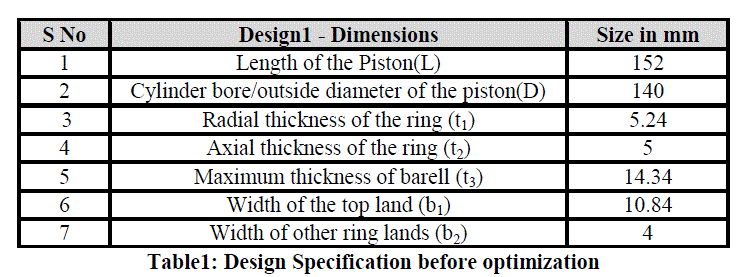 |
| Thus, the dimensions for the piston are calculated and these are used for modelling the piston in CATIA V5 R19. In the above procedure the ribs in the piston are not taken into consideration, so as make the piston model simple in its design. In modelling a piston considering all factors will become tedious process. Thus, a symmetric model is developed using the above dimensions. |
| Piston was modelled using CATIA V5 R19 software which is shown in Figure 1. |
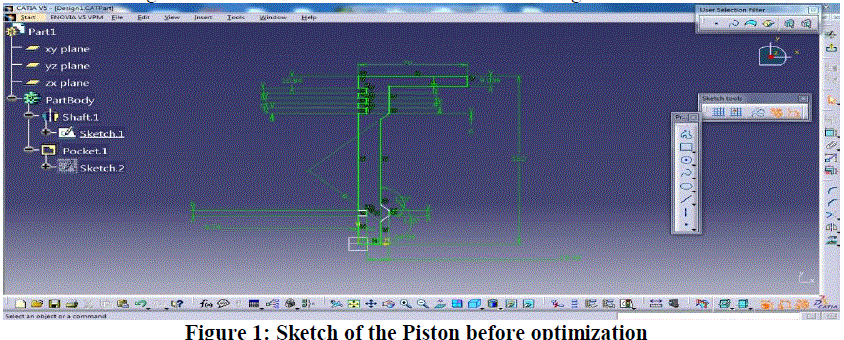 |
| The CAD and FEA of Piston |
| The design of the piston starts with the definition of the piston geometry using 3D CAD software. This 3D CAD geometric model is then imported to FEA software and analysed under the predicted service conditions before anything is made. That speeds up the design and testing process, reduces the lead time to create new pistons designs, and produces a better product. The idea behind finite analysis is to divide a model piston into a fixed finite number of elements. Computer software generates and predicts the overall stiffness of the entire piston. Analyzing the data it is possible predict how the piston will behave in a real engine and allows the engineer to see where the stresses and temperatures will be the greatest and how the piston will behave [5]. Analysis of the piston is done to optimize the stresses and minimize the weight using ANSYS. The mathematical model of optimization is established firstly, and the FEA is carried out by using the ANSYS software. Based on the analysis of optimal result, the stress concentrates on the piston has become evaluate, which provides a better reference for redesign of piston. |
MESHING OF PISTON BEFORE OPTIMIZATION |
| Element used is 20 node Tetrahedron named soilid90 [6]. The element size is taken as 5, then total number elements were 57630 and nodes were 91176 found in meshed model. |
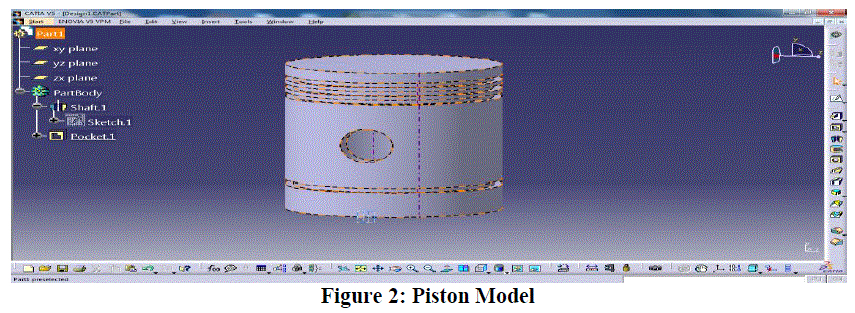 |
| THERMAL AND GEOMETRIC PROPERTIES OF THE PISTON MATERIAL |
| It is important to calculate the piston temperature distribution in order to control the thermal stresses and deformations within acceptable levels.. As much as 60% of the total engine mechanical power lost is generated by piston ring assembly. The piston skirt surface slides on the cylinder bore. A lubricant film fills the clearance between the surfaces. The small values of the clearance increase the frictional losses and the high values increase the secondary motion of the piston. Most of the Internal Combustion (IC) engine pistons are made of an aluminium alloy which has a thermal expansion coefficient, 80% higher than the cylinder bore material made of cast iron. The thermal and geometric properties are as shown in below : |
 |
| APPLYING TEMPERATURES, CONVECTIONS AND LOADS |
| The piston is divided into the areas defined by a series of grooves for sealing rings. The boundary conditions for mechanical simulation were defined as the pressure acting on the entire piston head surface (maximum pressure in the engine cylinder). It is necessary to load certain data on material that refer to both its mechanical and thermal properties to do the coupled thermo-mechanical calculations. The temperature load is applied on different areas and pressure applied on piston head. The regions like piston head and piston ring regions are applied with large amount of heat (160°C- 200°C). The convection values on the piston wall ranges from 232W/mK to 1570W/mK. and the working pressure is 2Mpa. |
OPTIMIZATION OF PISTON |
| After generating an accurate finite element model a strategy for the optimization workflow was defined. Target of the optimization was to reach a mass reduction of the piston. |
| Objective Function: Minimize mass |
| Subject to constraints: |
| (i) Maximum Vonmisses stress<Allowable or design stress |
| (ii) Manufacturing constraints |
| (iv) After carrying out static structural analysis the stresses in each loading conditions were studied and then area where excess material can be removed were decided so that maximum vonmisses stress does not exceed allowable and factor of safety is kept above 1.5 |
| (v) Following reasons where scope for material removal |
| Radial Thickness of the ring |
| Axial Thickness of the ring |
| Maximum Thickness of the Barrel |
| Width of the Top Land |
| Width of other ring lands |
| PISTON MODEL AFTER OPTIMAISATION |
| The meshing of the piston after optimization is done with the same element structure and size i.e., taken before optimization. The total number elements were 78221 and nodes were 47286 found in meshed model. |
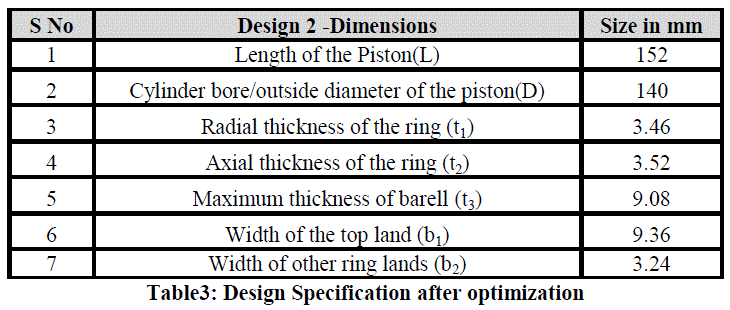 |
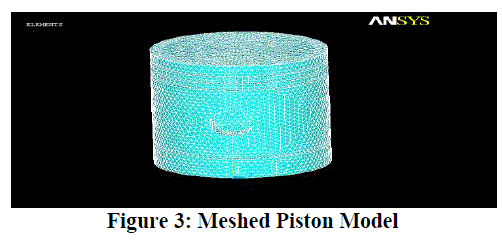 |
ANALYSIS RESULTS AND DISCUSSIONS |
| Analysis is the process of breaking a complex topic or substance into smaller parts to gain a better understanding of it. The current model is undergone Thermal Analysis and followed by Static Analysis, together called as Coupled Field Analysis. The meshed component is analyzed to find the thermal stresses of the piston. The component is subjected to the influence of heat conduction at the top of the piston and heat convection to side lands etc. The following images are shown for resulted deformation and vonmisses stresses before and after optimization |
| 1). Deformation and Vonmisses Stress before Optimization |
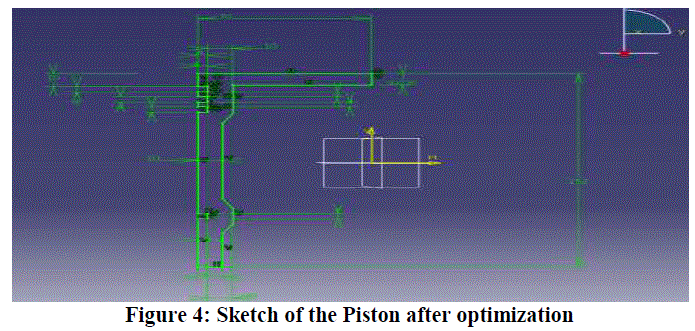 |
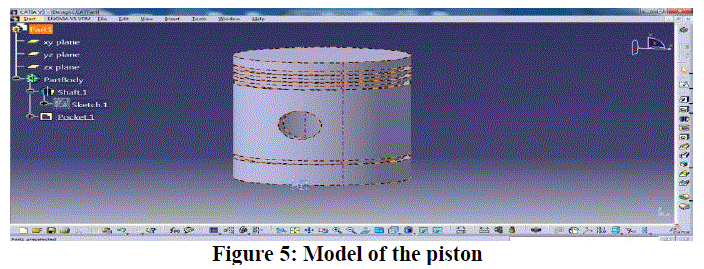 |
 |
| The length 152 mm and the diameter 140 are assumed to be constant. It is not considerable that the variations in piston length and diameter of the piston. The radial thickness of the piston has affected more as it is very small in size and the temperature and heat flow are very high to this size of thickness. Before optimization value is given as 5.24mm and obtained after optimization is 3.46mm. This is rounded to next highest value i.e., 4mm and is taken into consideration for design. The axial thickness of the piston ring before optimization is 5mm; it is changed to 3.52mm after optimization, since the more and more heat and stress applied through groves as it is very near to the head of the piston. This is rounded to next highest value i.e., 4mm is taken into consideration for design. The maximum thickness of the barrel before optimization is 14.34mm has much affected in variation of size after applying pressure and temperature loads and is changed to 9.08mm and rounded to next highest value i.e., 10mm taken into consideration. The initial value i.e., before optimization is 10.84mm and is changed after applying pressure which is directly applied on the head i.e., top of the piston as a result the shape of the piston on top will become just like a bowl. The value after optimization is obtained as 9.36mm and it is rounded to 10mm. This value is considerable for design. The width of the other lands i.e., near piston rings are 4mm in size and is changed due to pressure and heat applied on rings through groves. The value after optimization is 3.24mm and is rounded to 3mm. |
CONCLUSIONS |
| Piston skirt may appear deformation at work, which usually causes crack on the upper end of piston head. Due to the deformation, the greatest stress concentration is caused on the upper end of piston, the situation becomes more serious when the stiffness of the piston is not enough, and the crack generally appeared at the point A which may gradually extend and even cause splitting along the piston vertical. The stress distribution on the piston mainly depends on the deformation of piston. Therefore, in order to reduce the stress concentration, the piston crown should have enough stiffness to reduce the deformation. |
| 1. The optimal mathematical model which includes deformation of piston crown and quality of piston and piston skirt. |
| 2. The FEA is carried out for standard piston model used in diesel engine and the result of analysis indicate that the maximum stress has changed from 85 Mpa. to 55 Mpa. And biggest deformation has been reduced from 0.051762 mm to 0.025884 mm. |
FUTURE SCOPE OF THE WORK |
| Piston Design models are simulated on iteration based and it requires more number of iterations to check whether design is safe or not and to validate the models with the allowable. Instead of the above process, DOE – Design of Experiments concept can be used to optimize the design within short time and to get better optimized parameters. DOE should be carried in Ansys workbench. In Ansys workbench modelling can be done from Catia or Design Modeller using parametric model options. DP stands for design points, optimization can be done in workbench based on the required outputs namely deformations and stress with in prescribed limits. |
ACKNOWLEDGEMENT |
| The authors sincerely thank Department of Mechanical Engineering, JNTU College of Engineering Hyderabad for support, co-operation and encouragement that enabled this project. |
References |
|